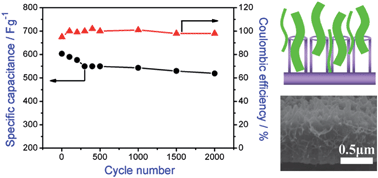Polyaniline nanowire array encapsulated in titania nanotubes as a superior electrode for supercapacitors
Abstract
Conducting

* Corresponding authors
a School of Metallurgical Science and Engineering, Central South University, Changsha, Hunan, China
b
Department of Applied Physics and Materials Research Center, The Hong Kong Polytechnic University, Hong Kong, China
E-mail:
aphhuang@polyu.edu.hk
Fax: +852-23337629
Tel: +852-27665694
c School of Materials Science and Engineering, South China University of Technology, Guangzhou, P. R. China
Conducting

 Please wait while we load your content...
Something went wrong. Try again?
Please wait while we load your content...
Something went wrong. Try again?
K. Xie, J. Li, Y. Lai, Z. Zhang, Y. Liu, G. Zhang and H. Huang, Nanoscale, 2011, 3, 2202 DOI: 10.1039/C0NR00899K
To request permission to reproduce material from this article, please go to the Copyright Clearance Center request page.
If you are an author contributing to an RSC publication, you do not need to request permission provided correct acknowledgement is given.
If you are the author of this article, you do not need to request permission to reproduce figures and diagrams provided correct acknowledgement is given. If you want to reproduce the whole article in a third-party publication (excluding your thesis/dissertation for which permission is not required) please go to the Copyright Clearance Center request page.
Read more about how to correctly acknowledge RSC content.
 Fetching data from CrossRef.
Fetching data from CrossRef.
This may take some time to load.
Loading related content
